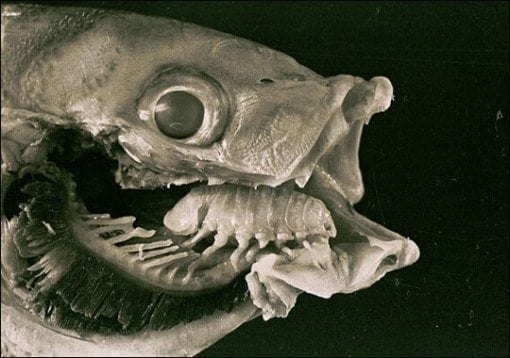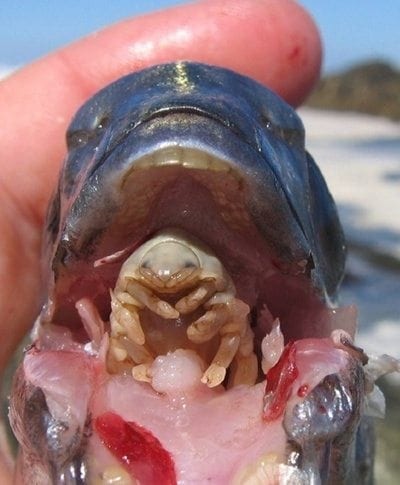Look on the Bright Side
Having a toothpick fish (the Candiru) take a detour up your urethra doesn’t really bear thinking about. The idea of maggots crawling around under your skin sickens you. It is true, humans are afflicted by some pretty nasty parasites. At least we can be thankful for bacon.
But things could be much, much worse.
Imagine a parasite that alters your appearance so that you look like food for something higher up in a food chain you have no place being in. That is exactly what happens when an Amazonian nematode infests an ant called Cephalotes atratus – the nematode turns their abdomens into juicy red berries that birds can’t resist. The nematode then gets a free ride all around the jungle.
A similar thing happens to snails infected by the trematode flatworm Leucochloridium paradoxum – the developing trematode offspring engorge the eye stalks of the snail making them look like pulsating green delicacies.
Or imagine you’re a builder and something comes along and deposits its larvae inside of you. These larvae take over your ‘mind’. You stop your current building projects, and before your impending death the larvae force you into building them a nice home to live in.
No, this isn’t science fiction, this is what happens when the web-building spider Plesiometa argyra is parasitised by the larvae of the wasp Hymenoepimecis argyraphaga. Another example of ‘arthropod mind control’ is the Nematomorph, or horse-hair, worm that makes grasshoppers jump into water – where they drown because they can’t swim (and the worm doesn’t bother to teach them)….
With the animal kingdom seemingly rife with ‘zombifying parasites’ (see the slide-show at Discover Magazine) it makes one wonder, are there strange parasites controlling what we do, that we don’t know about? Maybe that’s how we should view self-destructive memes like suicide bombing and the acceptance of quackery – as parasites of the mind. Having a Baloney Detection Kit handy is a good way to keep these parasites at bay.
Actually there may well be at least one ‘real’ ‘zombifying parasite’ out there affecting mammals (including humans) – check out this fascinating conversation with Robert Sapolsky on ‘Toxoplasmosis and Free Will’ from Edge.
But for me there is one parasite scenario that ‘out freaks’ all others:
Imagine a parasite that enters your body through your respiratory openings before latching onto the base of your tongue. Then, after snuggling into its new home, it feeds and grows by sucking the blood out of your tongue. Your tongue atrophies away to nothing. Then something truly weird happens. The parasite takes pity on you and actually replaces your tongue and does what your tongue once did!
For fish, this bizarre nightmare is a reality – the parasite is an isopod named Cymothoa exigua, the tongue-eating louse. This is believed to be the only example of a parasite the destroys a host organ then functionally replaces it.
So, remember, look on the bright side, OK?
Learn more about the wonderful world of parasites from Carl Zimmer (@CarlZimmer):
- ‘Do parasites rule the world?’
- The Wisdom of Parasites
- The book ‘Parasite Rex: Inside the Bizarre World of Nature’s Most Dangerous Creatures’
Chris is an Intensivist and ECMO specialist at The Alfred ICU, where he is Deputy Director (Education). He is a Clinical Adjunct Associate Professor at Monash University, the Lead for the Clinician Educator Incubator programme, and a CICM First Part Examiner.
He is an internationally recognised Clinician Educator with a passion for helping clinicians learn and for improving the clinical performance of individuals and collectives. He was one of the founders of the FOAM movement (Free Open-Access Medical education) has been recognised for his contributions to education with awards from ANZICS, ANZAHPE, and ACEM.
His one great achievement is being the father of three amazing children.
On Bluesky, he is @precordialthump.bsky.social and on the site that Elon has screwed up, he is @precordialthump.
| INTENSIVE | RAGE | Resuscitology | SMACC


